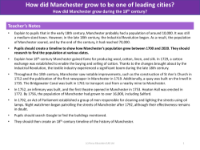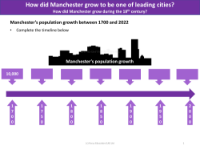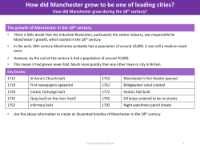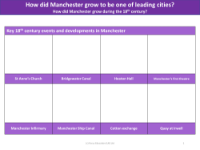How did Manchester grow during the 18th Century? - Presentation

History Resource Description
Manchester's transformation during the 18th century is a testament to the profound impact of the Industrial Revolution. Initially, around the early 1700s, Manchester was considered a medium-sized town with a population of approximately 10,000. The town was known for its production of wool, cotton, linen, and silk, and in 1729, the establishment of a cotton exchange marked a significant step in its economic development. As the century progressed, the textile industry boomed, catalysed by industrial advancements, leading to a dramatic population increase. By the century's close, Manchester's population had surged to around 70,000, reflecting a sevenfold growth and outpacing other British towns and cities.
This period of growth was marked by several key developments and infrastructure projects that shaped Manchester's urban landscape. St Ann's Church was constructed in 1712, followed by the city's first newspaper in 1719, which fostered communication and information dissemination. The creation of a quay on the River Irwell in 1735 and the Bridgewater Canal in 1761 enhanced transportation and trade, particularly for coal. The latter part of the century saw the establishment of an infirmary in 1752, the opening of Manchester's first theatre in 1753, and the construction of Heaton Hall in 1772. In a move to improve urban living conditions, 1792 saw the introduction of oil lamps to light the streets and the deployment of night watchmen, although their effectiveness was questionable. These developments were pivotal in Manchester's evolution into one of the leading cities of the time.





